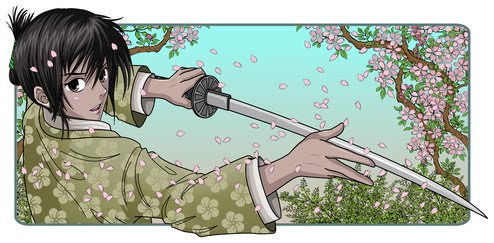There are lots of stories told about the relationship of the martial arts developed at the Shaolin temple (sometimes known as the "young forest temple") in Henan province and Bodhidharma. Many of them may be apocryphal, but that doesn't mean there isn't something to learn from them anyway.
The central idea is that Bodhidharma introduced the practice of meditation to the monks of Shaolin. The temple had apparently been a center of scholarly activity prior to this, and there was some resistance to the new direction he meant to take Buddhism in. But when Bodhidharma finally prevailed and persuaded the monks to take up his new meditation, he found that many of them were not prepared for its physical rigors. They tended to fall asleep. In order to improve their physical condition he designed an exercise regimen. The exercises he chose appear to have been borrowed from the fighting techniques (or wu shu) that already had a long tradition in that part of China.
What would Bodhidharma have brought to this tradition of wu shu? We might suppose that he introduced the focus on breathing techniques that are still characteristic of martial arts to this day. He may also have introduced a systematic character to wu shu training, which does not appear (at least on the surface) to be essential to learning to fight. His system, if we can call it that, would probably have included as its ultimate aim some form of spiritual enlightenment. This, too, we can easily recognize as a motif of many martial arts practiced to this day, even if it is a bit muted in many cases.
These have just been guesses about the meaning of a legend. Bodhidharma is usually credited with introducing a meditative form of Buddhism to China, a form that eventually made its way to Japan, where it was called Zen Buddhism. Its central ideas included meditation, controlled breathing and the yearning for spiritual enlightenment. One or another and sometimes all of these ideas are visible in martial arts as we know them today. These may well have developed naturally or accidentally over the centuries and have had no relationship to a single, historical person. That is certainly not inconceivable.
But there are texts that survive from the time of Bodhidharma's life which describe exercises that any student of the martial arts will recognize immediately. One such text describes the "horse stance" combined with a rotating punch technique, all to be performed while regulating one's breathing. These say nothing about Bodhidharma, but they testify to the great antiquity of techniques that survive even to this day.
Still, it is quite suggestive of the idea that some deeper truth underlies the martial arts. Our yearning for this deeper truth, and our sense of the martial arts as systematic, meditative practice is perhaps all we ought to take from the notion that Bodhidharma is their originator. We use his name to remind ourselves that martial arts can really be about something other than fighting, something deeper and more true.

No comments:
Post a Comment